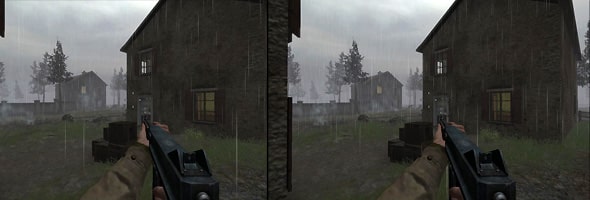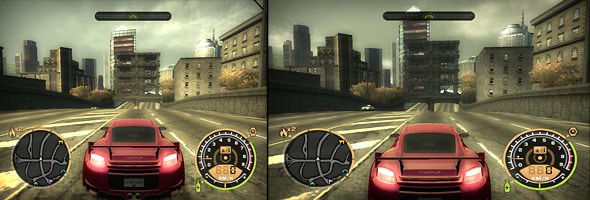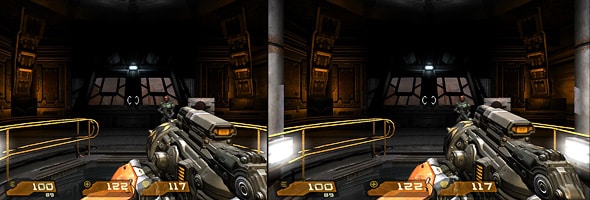Widescreen Gaming Woes
Man, was I ever stoked when I brought home my 21″ 16:10 LCD monitor. Unfortunately, that feeling didn’t last as long as I had hoped. It seems there’s several issues which hamper widescreen gaming that aren’t exactly common knowledge. Even after doing hours of research into pros and cons of having a widescreen LCD, I was met with many challenges and frustrating roadblocks that prevented me from jumping into the games I had been playing on my old 19″ CRT.
With the growing popularity of widescreen monitors and LCDs quickly taking over the monitor market share, I thought it would be a good idea to share my experiences and hopefully cut down the hours you might spend troubleshooting should you pick up a widescreen LCD.
First thing’s first. There’s some terminology you need to know and understand…
Resolution
You’ve no doubt heard the word “resolution” and understand what it is in terms of a computer monitor. For those that don’t, it’s the size that your screen is rendered at in pixels. Standard resolutions for non-widescreen monitors are 800×600, 1024×768, 1280×960, etc. The first number is the width in pixels, the second being height. With a CRT monitor, you can use pretty much any resolution and it will look fine. An LCD is different in that respect. It has a “native resolution” which is the physical amount of pixels it has to display. If you use a resolution outside of the native resolution, the monitor has to scale the image to fit the new size, which results in a blurry or fuzzy image. Definitely not optimal. For best results, always use the native resolution. This can be a bit of a problem, unless you have some heavy duty hardware as the bigger the screen size, the bigger the resolution. The native resolution for my monitor is 1680×1050 at which size I’m not able to run many games with the settings I would like. Typically, I have been running games at 1280×800.
You can probably imagine what happens when you run a resolution that is not the same aspect ratio as your monitor. Stretching. And it’s as ugly as it sounds. The image is literally stretched to fit the width of your monitor, producing less than desirable results. Unfortunately, you might have to endure this if a game doesn’t support widescreen resolutions and there’s no work around for it. Or even worse, you might not be able to play the game at all. I found that with my monitor, if the game wasn’t at a 16:10 resolution or in some cases even if there was stretching, the image becomes distorted. Little coloured boxes appear all over the place – as seen in the screenshot to the right.
Field of View (FOV)
Just as, if not more important as resolution is the field of view. FOV determines exactly how much we can actually see at the sides. A smaller FOV results in a tunnel like vision, where as a larger FOV ads more to your peripheral vision – how much you can see at the sides. If the FOV is set too large, you will get a fisheye effect where you can actually see to the left and right without having to look around. I’ve found that games that do support widescreen resolutions don’t adjust the FOV. So your image isn’t stretched, but you don’t see any more than you normally would on the sides and often enough, whatever object is in front of you (your gun, car, etc.) appears closer than it normally would or you can’t see quite as much of it.
Aspect Ratio
The aspect ratio is the size of the horizontal dimension relative to the vertical. A standard CRT monitor or non-widescreen LCD is 4:3. Widescreen LCDs are 16:10 and widescreen televisions (LCD, plasma, just about any HDTV) are 16:9.
VGA vs DVI
If your monitor is digital, you have one more variable to worry about. While using the DVI connection results in the brightest, sharpest and most vibrant image, you will once again run into problems if you don’t have the most high end hardware. Using the DVI connection means you have to run everything at the native resolution. You don’t have the option of running at lower resolutions and if you try, your game most likely won’t even start. My monitor has 5 inputs (DVI, VGA, Component, S-Video and Composite) and my videocard has dual DVI outs. I’m currently using both outputs, one with a VGA adapter which I use when playing games. The other a digital-to-digital connection which is my standard viewing mode. It’s rather unfortunate that I can’t run games using the DVI connection, but some of the more demanding games won’t run at anything more than low or medium settings at that resolution on my current rig.
The Worst Part
By far the most aggravating part of widescreen gaming is the lack of support from game developers. There are a handful of games that support 16:10 resolutions out of the box, and even less that really support it. I have come across a couple games that give the option to use 16:10 resolutions, but merely stretch the image to the specified size. You have to ask yourself why they bother at all?
Luckily for us, there is a pretty large and active community of gamers with widescreen monitors that are adamant to getting the experience they deserve. Enter Widescreen Gaming Forum. Much more than merely a forum, they have an extensive FAQ, user reviews of widescreen monitors and a master games list with solutions for getting your favourite games to run at 16:10 resolutions. I was fortunate to find this early on and it’s answered many questions I had an presented solutions for just about every game I own.
Results
Enough of the technical mumbo-jumbo. Let’s see this shit in action! Here’s a few comparisons of games running at 1024×768 and 1280×800 with explanations of how the widescreen resolution was achieved and if it’s true 16:10. Click on the images to see a larger comparison.
Call of Duty 2
One of the games I own with the best support for varying aspect ratios. Call of Duty 2 supports 4:3, 16:9 and 16:10 out of the box. There is no stretching at all. The FOV is appropriately adjusted and the HUD is repositioned to the screen edges.
F.E.A.R.
While F.E.A.R. doesn’t support an resolutions outside of the 4:3 aspect ratio, it’s very easy to customize the resolution to your needs. You have to manually edit the config file and change the resolution yourself. The FOV is adjusted automatically and HUD repositioned. Works mint and looks great!
Half-Life 2
It’s not surprising that Valve has covered all the bases here. Like COD2, HL2 supports all aspect ratios, correctly adjusts the FOV and repositions the HUD. I did notice that using a 4:3 resolution on my 16:10 monitor, the ammo count was positioned in a weird spot and cut off.
King Kong
King Kong is one of the unfortunate games that gives you the option to use a 16:10 resolution, but merely stretches the image to fit. Gross! Luckily, I finished the game on my 19″ CRT.
Need For Speed Most Wanted
By far, the biggest headache inducing game on the planet. NFSMW doesn’t support 16:10 resolutions and there’s no config/ini hack to correct it. Some dude created a resolution changer, which produces a a non-stretched image. But as you can see, the FOV wasn’t changed so the car appears far too close and you don’t gain any extra viewing space on the sides. I hear there’s a way to adjust the FOV using a camera hack, but haven’t bothered trying it yet. Also, the HUD is stretched producing oval shaped gages.
Quake 4
While it supports 16:9 out of the box, Quake 4 does not support 16:10. I believe this is probably due to the game also being available on the 360. In any case, changing the resolution and FOV is quick and easy (this method works for all games built on the Doom 3 engine). As you can see from the screenshot, there’s definitely a wider viewing space, but the HUD is stretched. I haven’t seen a fix for this, but honestly, it’s hardly noticeable at all. I’ve played many hours at 1280×800 and it looks sick.
Seem Like A Lot Of Work – Why Bother?
Good question – glad you asked! The experience of sitting in front of a screen that occupies most of your viewing space is simply immersive. I find that I get totally lost in the game and it greatly improves the experience overall. It gives a more natural viewing space, so especially for first person shooters, it feels more like you’re looking through a human’s eyes.
To be honest, this wasn’t my primary reason for getting a widescreen LCD. I work on the same machine I game on. I needed an LCD and the vast majority of 19″ LCDs only support 1280×1024. That resolution is simply not large enough for me. 1680×1050 that my 21″ supports is just lovely.





